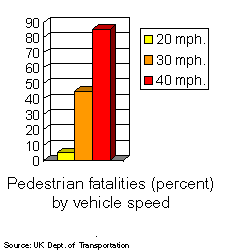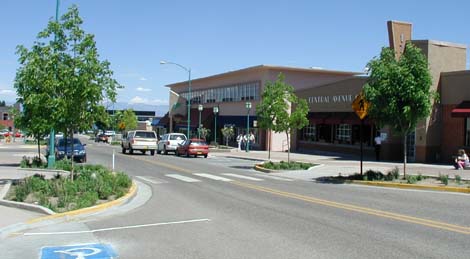|

 These two graphs give you an idea of the effect of vehicle speed.
Total stopping distance, which includes physical braking time plus the driver's
reaction time, increases with vehicle speed as shown. The driver of a faster-moving vehicle
must see a pedestrian sooner in order to slow or stop. If the driver fails to see a
pedestrian crossing the street, and the pedestrian is hit, the fatality rate dramatically
increases with vehicle speed.
These two graphs give you an idea of the effect of vehicle speed.
Total stopping distance, which includes physical braking time plus the driver's
reaction time, increases with vehicle speed as shown. The driver of a faster-moving vehicle
must see a pedestrian sooner in order to slow or stop. If the driver fails to see a
pedestrian crossing the street, and the pedestrian is hit, the fatality rate dramatically
increases with vehicle speed.
The effect of excessive speed is to increase pedestrian injuries and fatalities,
and to make pedestrians reluctant to cross, where speeds are high. Traffic volume
aggravates the problem, because there are fewer gaps in traffic during which is is safe
to step off the sidewalk. The end result is
that people do not walk, because they are afraid of crossing streets.
 Solving the problem is difficult. Police departments often lack the manpower to enforce
speed limits. Traffic engineers are reluctant to place crosswalks where they may give
pedestrians a false sense of security. One promising approach is "traffic calming": altering
the design of the street in some way that makes it natural for drivers to slow, particularly
where a crosswalk exists. The photo at right shows an example, where curb extensions or
"bulb-outs" narrow the road at a crosswalk, and trees are placed to narrow the driver's
visual field.
Solving the problem is difficult. Police departments often lack the manpower to enforce
speed limits. Traffic engineers are reluctant to place crosswalks where they may give
pedestrians a false sense of security. One promising approach is "traffic calming": altering
the design of the street in some way that makes it natural for drivers to slow, particularly
where a crosswalk exists. The photo at right shows an example, where curb extensions or
"bulb-outs" narrow the road at a crosswalk, and trees are placed to narrow the driver's
visual field.
Traffic calming can be a win-win situation, because it slows traffic down but makes
both driving and walking more visually appealing and pleasant (and safe). To find out more
about it, take a look at the Federal Highway Administrations's
traffic calming site.
The most important thing you can do is to let your public officials know that safe walking
needs to be a priority in the community, on an equal footing with vehicular traffic.
| 
